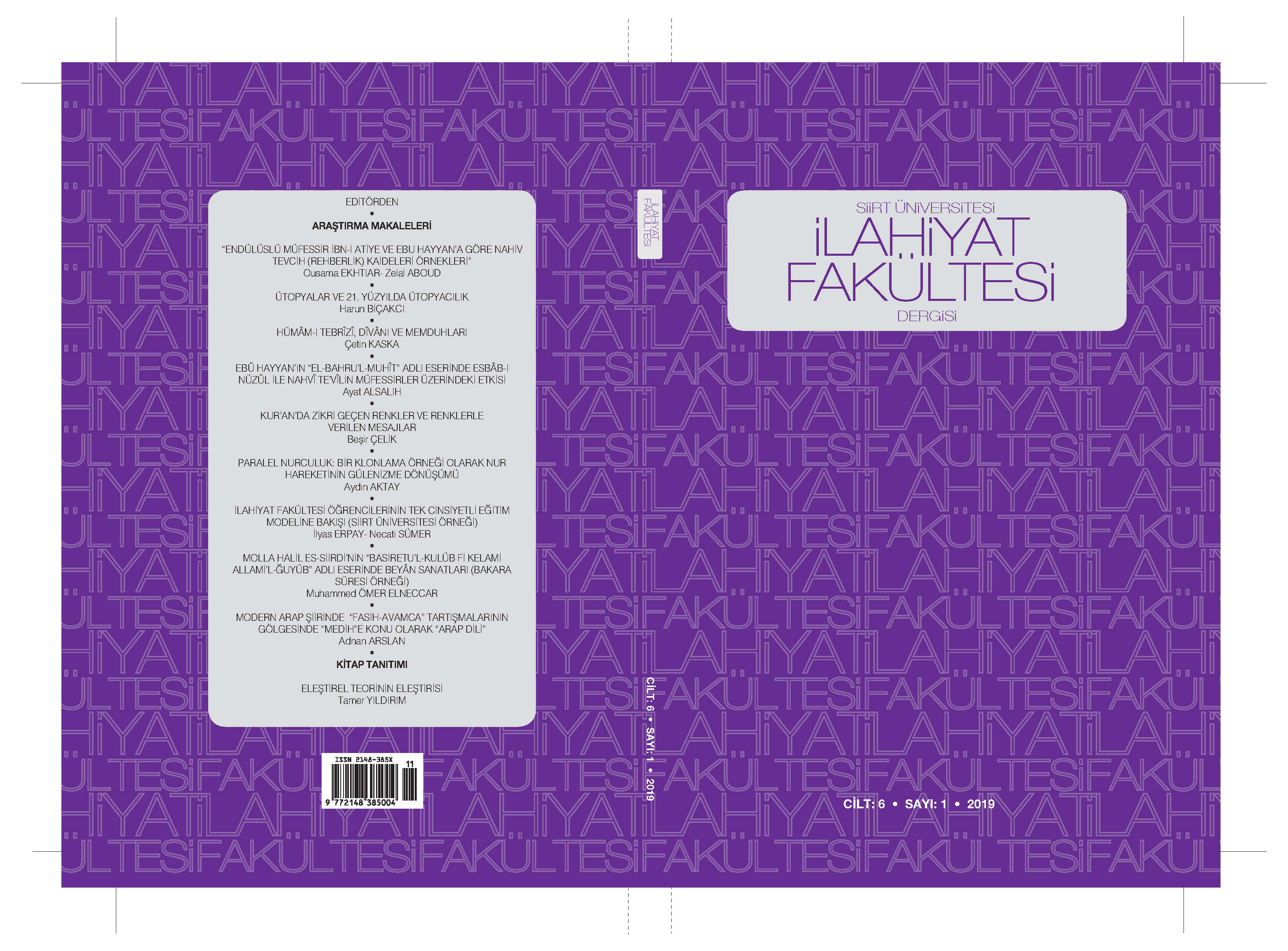Zeccâc’ın Me‘âni’l-Kur’ân ve İ‘râbuhu Adlı Eserinde İstişhâd Metodu
Arap dili alanında birçok eser telif etmiş olan Zeccâc, Me‘âni’l-Kur’ân ve İ‘râbuhu adlı tefsirinde âyetleri dil açısından incelemiş; kelime yapısı ve nahiv kurallarıyla ilgili beyanlarda bulunmuştur. Bu açıklamaları yaparken de Kur’ân’dan, Hadisten, şiirden ve Arap lehçelerinden istişhâdda bulunmuştur. Zeccâc’ın bu eserinde beş yüz civarı şiirle istişhâdda bulunduğu görülmektedir. Bu bağlamda çalışmamızda Zeccâc’ın Me‘âni’l-Kur’ân ve İ‘râbuhu adlı eserinde istişhâd metodu ele alınmıştır. Çalışma giriş ve üç ana başlıktan oluşmaktadır. Zeccâc’ın hayatına ve Me‘âni’l-Kur’ân adlı eserine kısaca temas edildikten sonra istişhâd kavramı ve Arap dilinde istişhâdın yeri ve önemi incelenmiş olup Zeccâc’ın Me‘âni’l-Kur’ân’ındaki istişhâd metodu örneklerle aktarılmıştır.
Anahtar Kelimeler:
Arap Dili, Zeccâc, Me'ani'l-Kurân, İstişhâd, Şiir
The Method of Attestation (Istishhād) in al-Zajjāj's Work Entitled Maʿānī al-Qur’ān wa Iʿrābuh
The subject of this article is the istishhād method used by Abû Ishâq al-Zajjāj (d. 311/923) in his work calledMa‘ānī al-Qur’ān wa i‘rābuh. Zajjāj, who lived in the third and fourth centuries of the Islamic calendar, is one ofthe leading scholars of the Arabic language. Zajjāj, who wrote various works in the field of Arabic language,wrote his most important work in the field of tafsir named Ma‘ānī al-Qur’ān wa i‘rābuh, in a long period ofabout sixteen years. In this work, Zajjāj examined the verses in terms of language and rhetoric, and also includedexplanations about word structure and syntax rules. In his analyzes and evaluations, it is seen that Zajjāj madeistishhād from verses of the Qur'an, Qur’anic recitation, hadiths, poems and Arabic dialects. The verses of theQur'an are at the forefront of the istishhāds used by Zajjāj in his mentioned work. Zajjāj, who applied to poemsin the second place, made istishhād with nearly five hundred poems in his work. In the present study, Zajjāj’s lifestory, his tafsir named Ma‘ānī al-Qur’ān and the characteristics of the work are briefly mentioned. Followingthis, the concept of istishhād, the place and importance of istishhād in Arabic language are examined. Finally, theistishhād method used by Zajjāj in his work named Ma‘ānī al-Qur’ān has been tried to be explained with someexamples.
Keywords:
Arabic Language, Zajjāj, Ma‘ānī al-Qur’ān, Attestation (Istishhād), Poetry,
___
- Abdunnûr, Cebbûr. el-Mu‘cemu’l-edebî. Beyrut: Dâru’l-‘İlim li’l-Melâyîn, 1979. Amudî, Mahmud Muhammed el-. “Mevkıfu’d-Demâmeynî mine’l-istişhâd bişi‘ri’l-muvelledin”. el-Mecelletu’l-İslâmiyye li’l-buhûsi’l-İnsaniyye 12/2 (2004). Bağdadî, Abdülkadir b. Ömer el-. Hizânetu’l-edeb ve lubbu lubâbi lisâni’l-‘arab. thk. Abdusselam Muhammed Harun. Kahire: Matba‘atü’l-Medenî, 1997.
- ISSN: 2757-752X
- Yayın Aralığı: Yılda 2 Sayı
- Başlangıç: 2014
- Yayıncı: Siirt Üniversitesi İlahiyat Fakültesi
Sayıdaki Diğer Makaleler
Fıkhın İstikrarı ve Donukluğu Arasında Dört Mezhebe Bağlılık- Analiz ve Mukayese
Bauman'ın Akışkan Modernite Kuramı Çerçevesinde Refleksif Sosyoloji Üzerine Bir Değerlendirme
Zeccâc’ın Me‘âni’l-Kur’ân ve İ‘râbuhu Adlı Eserinde İstişhâd Metodu
Dindarın Anlam Arayışının Temel Dinamiği Olarak Kutsal
Din ve Maneviyat Ekseninde Türkiye’de Dini Sosyal Hizmetler
Çocukların Mescidlerden Uzak Tutulmasını Bildiren Rivayetin Tahrîc ve Tahlîli
Nevevî’nin “El-Usûl ve’d-Davâbıt” Adlı Eseri: Tercüme ve Tahlîl
